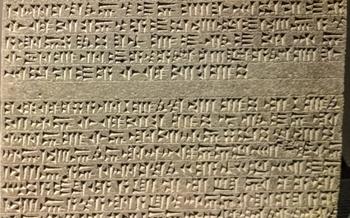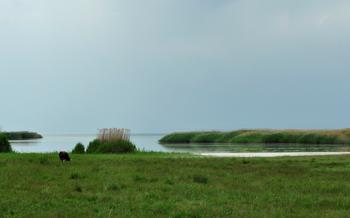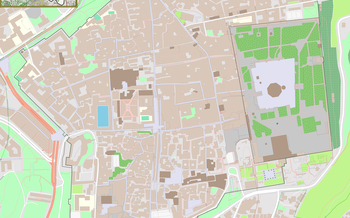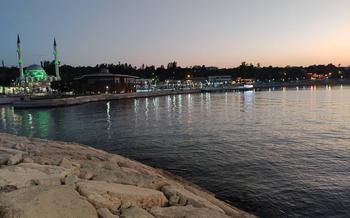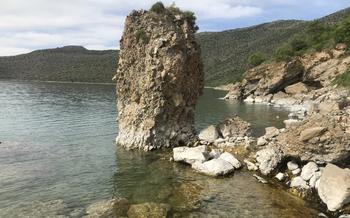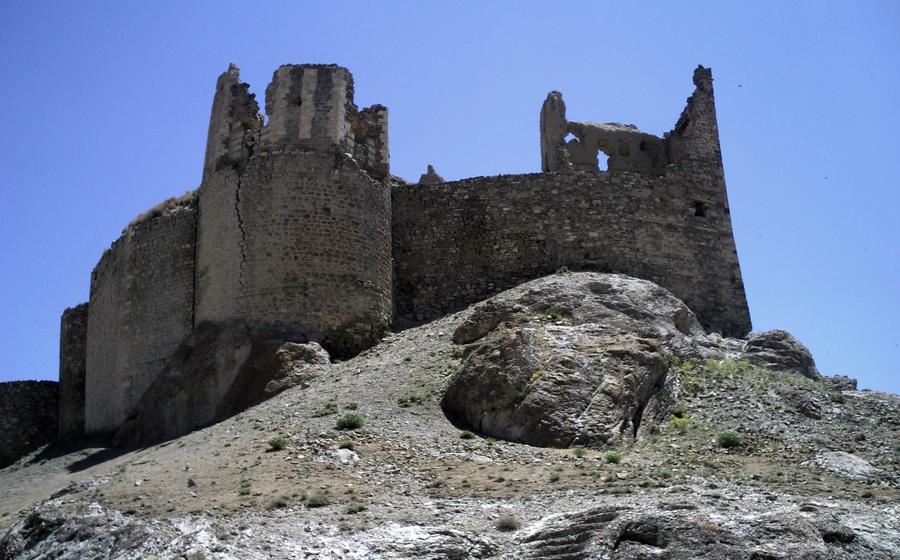
Hosap Castle (Hoşap Kalesi)
- History of Hosap Castle (Hoşap Kalesi)
- Location of Hosap Castle (Hoşap Kalesi)
- Architectural Features of Hosap Castle (Hoşap Kalesi)
- Panorama from Hosap Castle (Hoşap Kalesi)
- Exploring the Interior of Hosap Castle (Hoşap Kalesi)
- Hosap Castle (Hoşap Kalesi) as a Symbol of Resistance
- Visiting Hours and Admission Fees for Hosap Castle (Hoşap Kalesi)
- Getting to Hosap Castle (Hoşap Kalesi) from Van City Center
- Things to Do Near Hosap Castle (Hoşap Kalesi)
- Photography Tips for Capturing the Beauty of Hosap Castle
- Hosap Castle (Hoşap Kalesi) in Popular Culture and Media
- Local Festivals and Events at Hosap Castle (Hoşap Kalesi)
- Preservation and Conservation Efforts at Hosap Castle (Hoşap Kalesi)
- Insider Tip: Exploring the Secret Tunnel
History of Hosap Castle (Hoşap Kalesi)
Hosap Castle, a majestic fortress nestled in the picturesque landscapes of Van, stands as a testament to the region's rich history and architectural heritage. Built in the 17th century by the Ottomans, this formidable structure played a crucial role in safeguarding the eastern frontiers of the empire. Throughout the centuries, it has witnessed countless battles and sieges, serving as a defensive stronghold against invading forces. The castle's strategic location atop a hill overlooking the city of Van and the surrounding countryside made it an impregnable fortress, earning it a reputation as an indomitable symbol of resilience and power.
Its architectural style blends elements of Byzantine and Islamic influences, showcasing intricate stonework, imposing towers, and fortified walls. The castle's design reflects the military prowess and engineering skills of its builders, emphasizing its defensive capabilities. Hosap Castle stands as a proud symbol of Turkish architectural heritage, embodying the region's rich cultural tapestry and the enduring legacy of its past.
Location of Hosap Castle (Hoşap Kalesi)
Exact geographical coordinates: 38°38'27"N, 43°36'20"E
Distance from Van city center: Approximately 55 kilometers (34 miles)
Accessibility by public transportation: Regular buses and minibuses depart from Van's central bus station to the town of Hoşap, where the castle is located. From there, visitors can take a short taxi or minibus ride to the castle.
Nearby attractions:
-
Van Lake: The largest lake in Turkey, renowned for its scenic beauty and turquoise waters.
-
Van Museum: A treasure trove of artifacts and exhibits showcasing the rich history and culture of the Van region.
-
Akdamar Island: A picturesque island located on Van Lake, home to the historic Armenian Church of the Holy Cross.
Architectural Features of Hosap Castle (Hoşap Kalesi)
Hosap Castle (Hoşap Kalesi) showcases a unique architectural style that blends Armenian and Seljuk influences. Constructed using locally sourced stone, the castle features imposing walls reinforced by sturdy towers and fortified gates. The towers, strategically positioned along the perimeter, offer panoramic views of the surrounding landscape and served as defensive vantage points. The main gate, adorned with intricate carvings, is a testament to the craftsmanship of its builders. Inside the castle, visitors can explore a network of chambers, corridors, and hidden rooms, each with its own story to tell. These spaces once served as living quarters, storage rooms, and even secret passages, adding to the castle's mystique.
The castle's fortifications are a testament to its strategic importance. Multiple layers of defense, including moats, drawbridges, and arrow slits, made it virtually impregnable to invaders. These features, combined with the castle's elevated position, allowed it to withstand numerous sieges and attacks throughout history. The castle's resilience is a testament to the ingenuity and determination of its builders, who created a fortress that would stand the test of time.
Panorama from Hosap Castle (Hoşap Kalesi)
The panorama that unfolds from the ramparts of Hosap Castle is nothing short of breathtaking. The vast expanse of Van Lake stretches out before you, its shimmering waters reflecting the ever-changing hues of the sky. In the distance, the majestic city of Van rises from the shores of the lake, its skyline punctuated by minarets and domes. The surrounding landscape is a tapestry of lush valleys and imposing mountain ranges, creating a picture-perfect backdrop for this historic fortress.
Every angle you turn reveals a new vista. To the east, the towering peaks of the Suphan Mountain range dominate the horizon, their snow-capped summits glistening in the sunlight. To the west, the fertile plains of the Van Basin stretch out as far as the eye can see, dotted with villages, fields, and orchards. The castle's strategic location allowed its inhabitants to keep watch over this vast and diverse territory, controlling access to the region and defending it from potential invaders.
Whether you're a nature enthusiast, a history buff, or simply someone who appreciates stunning views, the panorama from Hosap Castle is sure to leave you in awe. Be sure to bring your camera to capture the beauty of this unique landscape, and take some time to soak in the tranquility and serenity of this ancient fortress.
Exploring the Interior of Hosap Castle (Hoşap Kalesi)
Venturing into the castle's interior is like stepping into a time capsule, where history and mystery intertwine. Every corner beckons with secrets waiting to be unveiled. Explore the intriguing chambers and corridors, each telling a tale of the castle's past. Discover hidden rooms and secret passages that lead to unexpected vistas. Along the way, unearth historical artifacts and inscriptions that provide glimpses into the lives of those who once inhabited this fortress. Let the atmosphere of a bygone era envelop you as you explore the depths of Hosap Castle (Hoşap Kalesi), a true testament to the enduring spirit of the past.
Hosap Castle (Hoşap Kalesi) as a Symbol of Resistance
Hosap Castle's strategic location and formidable fortifications made it a crucial defensive stronghold throughout history. It withstood numerous sieges and invasions, serving as a symbol of resilience and determination for the local people. The castle's ability to endure against all odds is a testament to the strength and unity of the community.
One notable instance of the castle's resilience occurred during the Ottoman-Safavid wars in the 16th century. Despite being outnumbered and outgunned, the castle's defenders held out against a prolonged siege by the Safavid army. Their unwavering resistance and refusal to surrender ultimately forced the Safavids to withdraw.
The castle's symbolic significance extends beyond its military history. It represents the cultural and historical identity of the region, embodying the spirit of resistance and self-determination. Today, Hosap Castle stands as a proud reminder of the enduring strength and resilience of the local people, inspiring generations to come.
Visiting Hours and Admission Fees for Hosap Castle (Hoşap Kalesi)
Planning a visit to Hosap Castle is an enriching experience that offers a glimpse into Turkey's rich history and culture. To make the most of your visit, it's important to be aware of the visiting hours and any applicable admission fees.
The castle is open to the public daily, providing ample opportunities for exploration. During the summer months (June to September), the visiting hours are extended to accommodate the increased number of tourists. It's advisable to arrive early in the morning or late in the afternoon to avoid the midday heat and capture the best light for photography.
Admission to the castle is free of charge, allowing visitors to enjoy the historical site without any financial burden. This makes it an accessible and affordable destination for travelers. It's worth noting that guided tours are not typically offered, but visitors can explore the castle independently and immerse themselves in its captivating atmosphere.
For those interested in capturing the essence of the castle through photography, it's essential to be mindful of any restrictions or guidelines regarding the use of tripods or professional photography equipment. Respecting these regulations ensures the preservation of the site for future generations.
By planning your visit during the appropriate hours and being aware of any potential fees or restrictions, you can fully embrace the experience and delve into the captivating history and beauty of Hosap Castle.
Getting to Hosap Castle (Hoşap Kalesi) from Van City Center
Reaching Hosap Castle from Van city center is a straightforward journey. You can opt for public transportation or drive your own vehicle.
For those relying on public transport, there are regular buses and minibuses departing from the Van Otogar (bus terminal) to Hosap town. The journey takes approximately 1 hour and 30 minutes. Upon arrival in Hosap, you can take a short taxi ride or walk to the castle, which is located on a hill overlooking the town.
If you prefer the convenience of driving, rent a car and follow the D300 highway towards Hosap. The drive takes about 1 hour and 15 minutes. Once in Hosap, follow the signs to the castle. Parking is available near the castle's entrance.
Remember, the roads in the region can be narrow and winding, so drive cautiously and adhere to local traffic regulations.
Things to Do Near Hosap Castle (Hoşap Kalesi)
Your visit to Hosap Castle can be enriched by exploring the surrounding area, which offers a diverse range of attractions and activities. History buffs can delve deeper into the region's past at the Van Museum, which houses a collection of artifacts and exhibits showcasing the rich cultural heritage of Van. To experience the natural beauty of the region, embark on a boat trip on Van Lake, the largest lake in Turkey, and admire the stunning scenery from a unique perspective.
For those seeking culinary delights, the city of Van offers an array of traditional restaurants serving mouthwatering dishes that reflect the region's unique flavors and culinary traditions. Indulge in the tantalizing tastes of Van kebab, a local specialty, or savor the delectable trout fish, freshly caught from Van Lake.
Beyond these attractions, the vicinity of Hosap Castle offers additional opportunities for exploration. Discover the historic Van city center, with its narrow cobblestone streets and charming Ottoman-era architecture. Visit the ancient ruins of Çavuştepe, a Bronze Age settlement that offers a glimpse into the region's early history. Immerse yourself in the vibrant local culture by attending one of the many festivals and events held throughout the year, showcasing traditional dances, music, and handicrafts.
Photography Tips for Capturing the Beauty of Hosap Castle
Hosap Castle's imposing presence and stunning backdrop make it a photographer's paradise. To capture its grandeur, consider using a wide-angle lens to encompass the castle's entirety against the vast landscape. Experiment with different angles, shooting from various vantage points, such as the base of the castle or from higher elevations to showcase its scale and majesty.
Pay attention to the interplay of light and shadow, particularly during the golden hours of sunrise and sunset when the castle's stones exude a warm glow. Utilize natural light to enhance the visual impact of your shots, creating dramatic contrasts and depth.
For unique perspectives, explore the castle's interior, capturing the intricate details of its chambers, corridors, and hidden corners. Experiment with different focal lengths and apertures to achieve varying effects, from sharp close-ups to atmospheric wide shots.
To capture the essence of Hosap Castle, don't be afraid to experiment with creative compositions. Try incorporating elements of the surrounding landscape, such as the mountains, lake, or vegetation, to create a sense of place and context.
Hosap Castle (Hoşap Kalesi) in Popular Culture and Media
Hosap Castle's captivating allure has extended beyond its historical significance, capturing the imagination of artists and storytellers alike. It has served as a backdrop for numerous literary works, films, and television shows, becoming a symbol of resilience, intrigue, and timeless beauty.
In the realm of literature, the castle has been immortalized in the writings of renowned Turkish authors such as Yaşar Kemal and Orhan Pamuk. Their evocative descriptions of the castle's grandeur and its role in shaping the region's history have captivated readers worldwide, bringing the fortress to life in their imaginations.
On the silver screen, Hosap Castle has graced the scenes of several historical dramas and adventure films. Its imposing presence and well-preserved architecture have made it a popular choice for filmmakers seeking authentic settings. In one notable film, the castle served as the backdrop for a thrilling tale of love, betrayal, and redemption set against the backdrop of the Ottoman Empire.
The castle's enigmatic aura has also caught the attention of television producers. In a recent documentary series exploring Turkey's hidden gems, Hosap Castle featured prominently, showcasing its architectural marvels and delving into its rich history. The program shed light on the castle's role as a defensive stronghold and its enduring significance to the local community.
Through these artistic representations, Hosap Castle has transcended its physical existence, becoming a cultural symbol that resonates with people worldwide. Its portrayal in popular culture has played a crucial role in promoting the region's tourism industry, attracting visitors eager to experience the magic of this ancient fortress for themselves.
Local Festivals and Events at Hosap Castle (Hoşap Kalesi)
Hosap Castle, with its rich history and cultural significance, serves as a backdrop for several local festivals and events throughout the year. These events provide a unique opportunity for visitors to immerse themselves in the region's traditions and customs while exploring the castle's grounds.
One of the most notable events is the Hosap Castle Festival, held annually in the summer months. This vibrant festival showcases traditional music, dance, and cuisine, attracting both locals and tourists alike. Visitors can witness traditional performances, savor local delicacies, and participate in various cultural activities, creating a lively and festive atmosphere within the castle walls.
Another significant event is the Hoşap Kalesi Restoration Festival, which focuses on celebrating and supporting the ongoing efforts to preserve and restore the castle. This festival brings together experts, volunteers, and community members who share their knowledge and skills in restoration techniques. Visitors can learn about the history and significance of the castle, witness live demonstrations, and contribute to its preservation by participating in workshops and hands-on activities.
By attending these local festivals and events, visitors can gain a deeper understanding of the cultural heritage of the region and experience the castle in a unique and immersive way. It's recommended to plan a visit during these special occasions to fully appreciate the vibrant atmosphere and rich traditions that come alive within the walls of Hosap Castle.
Preservation and Conservation Efforts at Hosap Castle (Hoşap Kalesi)
Hosap Castle has undergone several preservation and conservation efforts over the years to protect and restore its historical significance. Local authorities, in collaboration with organizations dedicated to heritage preservation, have implemented initiatives to safeguard this architectural gem.
One of the primary challenges faced in the conservation process is the castle's vulnerability to natural elements, particularly earthquakes and erosion. The castle's strategic location on a hilltop exposes it to strong winds and temperature fluctuations, which can weaken its structure over time.
To address these challenges, restoration work focuses on reinforcing the castle's foundations, repairing damaged walls and towers, and implementing measures to prevent further deterioration. Traditional construction techniques and materials are employed to maintain the castle's authenticity and historical integrity.
Additionally, efforts are made to preserve the castle's unique architectural features, such as its intricate carvings, inscriptions, and decorative elements. These details provide valuable insights into the craftsmanship and artistic traditions of the past, and their preservation ensures that future generations can appreciate the castle's cultural significance.
Visitors to Hosap Castle can contribute to its preservation by following designated pathways, refraining from climbing on the castle walls, and avoiding touching or damaging the historical artifacts. Responsible tourism practices help ensure that the castle remains a symbol of resilience and a source of pride for the local community.
Insider Tip: Exploring the Secret Tunnel
Hidden deep within the depths of Hosap Castle lies a secret tunnel, a testament to the ingenuity and resourcefulness of its builders. This subterranean passageway, shrouded in mystery and intrigue, served as a vital escape route in times of siege, allowing the castle's inhabitants to flee to safety or launch surprise attacks on unsuspecting enemies.
To discover the entrance to this hidden tunnel, visitors must venture into the castle's darkest corners, where a concealed doorway blends seamlessly with the ancient stone walls. Once inside, they will find themselves in a narrow, dimly lit corridor that winds its way through the very foundations of the castle.
Exploring the tunnel is a thrilling experience, but it requires caution and a sense of adventure. The path is uneven, and the air is damp and musty, but the rewards are immense. As visitors progress deeper into the tunnel, they will feel a palpable connection to the castle's rich history and the brave souls who once traversed these hidden passageways.
The tunnel eventually leads to an opening concealed by dense vegetation, providing a discreet exit point outside the castle walls. This secret passageway served as a lifeline for the castle's defenders, enabling them to escape capture or seek reinforcements when under attack.
Unveiling the secrets of the hidden tunnel is an unforgettable experience that adds an extra layer of intrigue to a visit to Hosap Castle. It is a tangible reminder of the castle's strategic importance and the ingenuity of its builders, who left behind a legacy that continues to fascinate and inspire visitors to this day.


